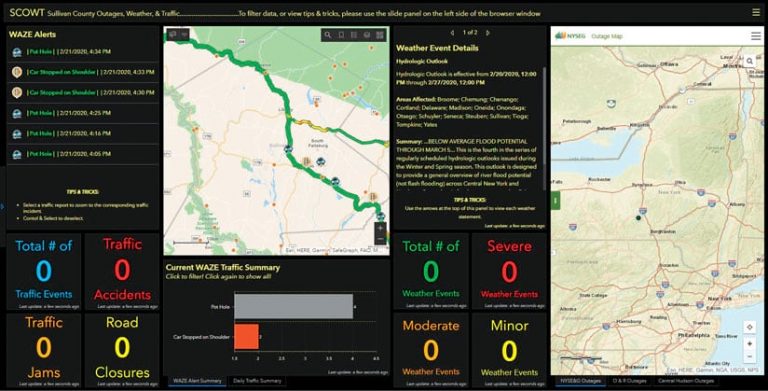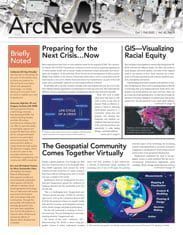Sullivan County, New York, known as the gateway to the Catskill Mountains, is a 90-minute drive northwest of New York City. Rich in cultural, historical, and recreational landmarks, the area has been an on-again, off-again tourist destination for city dwellers for 200 years.
In the 1980s and 1990s, the tourism industry there suffered, and Sullivan County has since struggled to bounce back from the 2008 recession. But now, with New Yorkers’ renewed interest in vacationing close to home, the county’s population of 76,330 people rapidly swells to more than three times that amount during the summer months.
Frequently cash-strapped and under-resourced, the county government wanted to find a way to help its staff balance tourism needs with the realities of country living. That solution turned out to be GIS, which Sullivan County now uses to empower not only local government employees but also the public.
GIS Proves Its Value Early On
Sullivan County’s Real Property Tax Services Agency, in which the Sullivan County GIS program began, has long understood the value of GIS.
In 2006, staff members in Real Property converted the county’s tax maps from Mylar and paper maps to ArcGIS Desktop. The power of this new digital system was immediately apparent: technicians were able to do in minutes what previously would have taken hours, from plotting parcels to identifying data errors. Additionally, having quality basemap data improved efficiency and empowered this small office to develop more sustainable, financially feasible solutions to a range of issues.
For example, in 2011, when Sullivan County had to lay off a number of employees, Real Property absorbed two additional responsibilities: maintaining 911 addressing and administering the county’s GIS. With half the staff and at least twice the amount of work, Real Property sought to use existing resources to accommodate the additional workload and an expanded customer base.
First, the team focused on building custom tools to digitize paper-based tasks and streamline manual duties. Employing ModelBuilder, Real Property staff members automated a number of tasks, such as populating databases and exporting shapefiles. This allowed them to spend more time on data development for other departments, as well as a new initiative: implementing Web GIS.

A few years later, Real Property’s budding GIS program was able to use the county’s existing ArcGIS Online account to develop and release its first online GIS app, the Address Verification App (AVA). AVA, which helps community members and local business owners verify that they’re using the correct 911 address, taught the county an invaluable lesson—that empowering the public can, in turn, empower local government.
Sullivan County realized its return on investment on this app immediately. The number of on-site customers and requests for address verification letters dwindled as use of AVA took off, averaging more than 15 views per day during the first year and increasing ever since. Currently, that amounts to 30 customers, phone calls, questions, and/or letters per day—or nearly 8,000 per year—that overwhelmed staff members no longer have to handle.
AVA’s success showed that Sullivan County residents were ready to embrace building a smarter community, one that views existing problems through a map-based lens. With growing support from the public and other county departments, it was time to build a new, mapcentric approach for another old-school process.
Summer Plans Inspire a Digital Overhaul
Prior to 2018, emergency management in Sullivan County was technologically limited.
“Monitoring of the news and the public safety radio frequencies, along with relying on first responders in the field to provide situational awareness, was the primary means of monitoring [an event],” said Rick Sauer, Sullivan County’s commissioner of public safety. “There was no written plan for EOC [emergency operations center] activations.”
But at that time, Sullivan County was anticipating the 50th anniversary of the Woodstock music festival, which took place there in 1969. To mark the occasion, the county planned a series of live concerts at the Bethel Woods Center for the Arts from August 15 to 18, 2019. But there were four other major events happening in the county at the same time: a two-day music and arts festival, the Grahamsville Little World’s Fair, a Boy Scouts camp-out, and family day at local campgrounds.
In preparation for a massive influx of visitors, staff members from Sullivan County’s EOC began exploring how they could improve their incident monitoring and response capabilities, along with their situational awareness. Sauer worked with the 911 Center; the Bureau of Fire; the Bureau of Emergency Medical Services; the director of communications; the GIS program; and a number of federal, state, and local officials to establish a new EOC plan that took advantage of the county’s technological resources. GIS ended up being a critical component of the multitiered solution.
Sullivan County’s GIS program first used ArcGIS Pro to deploy ArcGIS Solutions for Emergency Management, a suite of ready-made configurations for ArcGIS that focus on preparedness, response, recovery, and mitigation. Using these solutions, the team created four apps for EOC staff members: Operations Response, which helps users identify and map emergency facilities; Situational Awareness, which lets users map event and incident perimeters and identify affected populations; Logistics Planning, which helps users outline emergency logistics; and the Emergency Resources Reporter, which allows users to streamline field data collection via an offline map with sync capabilities and an online reporter. All components of the solution are now collectively known as the Emergency Operations Suite.
Being able to easily deploy these resources enabled the county to more effectively map and monitor all its public safety assets and resources. It also helped the team quickly provide maps and updates and identify any additional critical information.
“All these efforts provided for a successful 50th Woodstock Anniversary weekend by increasing situational awareness [by] leaps and bounds, having the right people in the room at the right time, and assisting decision-makers,” said Sauer.
What’s more, restructuring the EOC to use the Emergency Operations Suite—along with live-feed camera systems, cell phone technology, drones, and social media—throughout that weekend has allowed Sauer and his team to more effectively monitor and coordinate other public safety and emergency management incidents that affect Sullivan County’s residents and visitors.
A Sustainable GIS Platform Emerges
One of the biggest improvements Sullivan County has seen with implementing GIS for emergency management is being able to use a GIS-based dashboard, called the Sullivan County Outages, Weather, and Traffic (SCOWT) dashboard, to monitor multiple data sources on one screen.
“This is used on a daily basis by the commissioner of public safety and the fire coordinator to monitor traffic, electrical outages, and weather alerts,” said Sauer. “We have taken advantage of this technology to share needed information [with] the public through our public information officer.”
Staff members from the GIS program created SCOWT using ArcGIS Online, along with a number of Esri-provided resources and collaborations, including the Waze Live Alerts Layer, available on ArcGIS Marketplace. Through its Waze for Cities partnership, Sullivan County obtains near real-time traffic incident and road closure data at no cost—a huge benefit for a county that’s regularly low on funding. Taking advantage of Waze’s crowdsourced data allows the Sullivan County EOC to monitor the Waze traffic incident reports that drivers submit every day.
Other resources provided by Esri include streaming feature services for weather, flooding, and traffic. Combining these with embedded outage maps from local utility companies in the SCOWT dashboard allows public safety organizations to take advantage of mapcentric monitoring capabilities.
Moving forward, these GIS resources—along with a multiuser geodatabase environment; a new enterprise GIS implementation; and additional support from the Sullivan County IT Department, where the GIS program is now housed—will enable Sullivan County to continue empowering its staff and the public with an efficient, financially responsible, and sustainable GIS platform for years to come.


